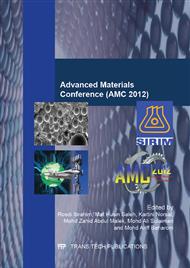[1]
K. Yamaguchi, N. Takakura, S. Imatani, Compaction and sintering characteristics of composite metal powder, Journal of Material Processing Technology. 63 (1997) 364-369.
DOI: 10.1016/s0924-0136(96)02648-9
Google Scholar
[2]
H.G. Rutz, F.G. Hanejko, High density processing of high performance ferrous materials, International Journal of Powder Metallurgy 31 (1999) 9-17.
Google Scholar
[3]
G. Dowson, Introduction to Powder Metallurgy, EPMA education aid, MPR Publishing Services Ltd., United Kingdom, 1988.
Google Scholar
[4]
K. Takeuchi, The p/m materials from the viewpoint of environment, Proceedings of 2000 PM World Congress, 1 (2000) 204-208.
Google Scholar
[5]
M.M. Rahman, S.S.M. Nor, An experimental investigation of metal powder compaction at elevated temperature, Mechanics of Materials 41 (2009) 553-560.
DOI: 10.1016/j.mechmat.2008.12.003
Google Scholar
[6]
A.K. Ariffin, M.M. Rahman, The study of warm metal powder compaction, Journal of the Institute of Materials Malaysia 1 (2003) 161-174.
Google Scholar
[7]
U. Engston, E. Johanson, Experience with warm compaction of DensmixTM powder in the production of complex parts, Höganäs AB., Sweden, (2003).
Google Scholar
[8]
S.S.M. Nor, M.M. Rahman, F. Tarlochan, B. Shahida, The effect of lubrication in reducing net friction in warm powder compaction process, Journal of Materials Processing Technology 207 (2008) 118-124.
DOI: 10.1016/j.jmatprotec.2007.12.081
Google Scholar
[9]
S. Simchi, Effects of lubrication procedure on the consolidation, sintering and microstructural features of powder compacts, Materials and Design 24 (2003) 585-594.
DOI: 10.1016/s0261-3069(03)00155-9
Google Scholar
[10]
M.M. Rahman, F. Tarlochan, S. Ramesh, A.K. Ariffin, S.S.M. Nor, Numerical simulation and experimentation of warm metal powder compaction process, Key Engineering Materials 462-463 (2010) 704-709.
DOI: 10.4028/www.scientific.net/kem.462-463.704
Google Scholar
[11]
Y. Kanno, J.A.C. Martins, A.P. Costa, Three-dimensional quasi-static frictional contact by using second-order cone linear complementarity problem, International Journal for Numerical Methods in Engineering 65 (2006) 62-83.
DOI: 10.1002/nme.1493
Google Scholar
[12]
M.M. Rahman, S.S.M. Nor, An experimental investigation of T-shape component forming through warm powder compaction route, Malaysian Symposium on Advances in Powder Metallurgy and Particulate Materials 2007 (APM2 07), Universiti Teknologi MARA (UiTM) Shah Alam, 21-22 August, 2007.
DOI: 10.30880/ijie.2018.10.09.011
Google Scholar
[13]
M.M. Rahman, S.S.M. Nor, An experimental investigation on the metal powder compaction at various lubricant contents and forming loads, The 2nd International Conference on Engineering and ICT (ICEI2010), Melaka, 18th-20th February, 2010.
Google Scholar
[14]
A. Babakhani, A. Haerian, M. Ghambari, On the combined effect of lubrication and compaction temperature on properties of iron-based p/m parts, Materials Science and Engineering A 437 (2006) 360-365.
DOI: 10.1016/j.msea.2006.08.008
Google Scholar
[15]
M.M. Rahman, S.S.M. Nor, H.Y. Rahman, Investigation on the effect of lubrication to the mechanical properties of green compacts formed through warm compaction route, World Engineering Congress, 2nd-5th August 2010, Kuching, Sarawak, Malaysia, 2010.
Google Scholar
[16]
M.M. Rahman, F. Tarlochan, S. Ramesh, A.K. Ariffin, S.S.M. Nor, M.R. Jamli, Production of near-net-shape metal powder compact through warm compaction route- an experimental investigation, International Conference on Recent Advances in Mechanical & Materials Engineering, 30-31 May 2005, Kuala Lumpur, Malaysia, 2005.
Google Scholar
[17]
S. Turenne, C. Godere, Y. Thomas, P.E. Mongeon, Evaluation of friction condition in powder compaction in admixed and die wall lubrication, International Journal of Powder Metallurgy 42 (1999) 263-268.
DOI: 10.1179/003258999665611
Google Scholar
[18]
M.M. Rahman, S.S.M. Nor, H.Y. Rahman, I. Sopyan, Effects of forming parameters and sintering schedules to the mechanical properties and microstructures of final components, Materials and Design 33 (2012) 153-157.
DOI: 10.1016/j.matdes.2011.07.019
Google Scholar
[19]
M.M. Rahman, M.A.S. Wardi, S.S.M. Nor, Effect of feedstock preparation to the final properties of warm formed powder compacts, Proceedings of International Conference on Mechanical Engineering Research, 1-3 July 2013, Kuantan, Malaysia.
DOI: 10.15282/ijame.8.2013.4.0092
Google Scholar
[20]
M.M. Rahman, S.S.M. Nor, Sintering schedule for near-net shape manufacturing through warm forming route, Proceedings of Advanced Materials Conference, 12-13 December 2012, Langkawi, Malaysia, 276-279.
Google Scholar


